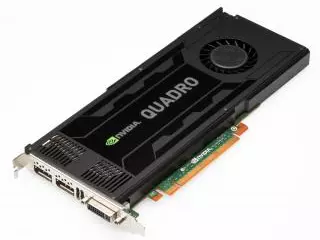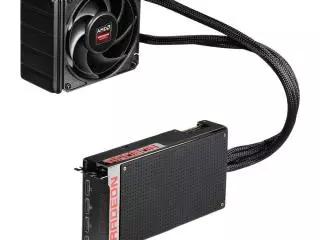Quadro K4200 vs Radeon R9 FURY X
If you are going to buy a new graphics card and are choosing between Quadro K4200 and Radeon R9 FURY X, there are a couple of things to consider. Cards with more VRAM in general perform better and allow you to play on higher graphics settings. Size also makes a difference. A model with a large heatsink can occupy up to three expansion slots on a motherboard. Be sure you have enough room in your PC case. When comparing GPUs with different architectures, more processing cores and even higher TFLOPS will not always translate to better performance. To help you decide which GPU you need, we have measured frame rates in a number of popular games. For more on how the Quadro K4200 stacks up against Radeon R9 FURY X, check out specs charts below.
Main Specs
Quadro K4200
Radeon R9 FURY X
Power consumption (TDP)
108 Watt
275 Watt
Interface
PCIe 2.0 x16
PCIe 3.0 x16
Supplementary power connectors
1x 6-pin
2x 8-pin
Memory type
GDDR5
High Bandwidth Memory (HBM)
Maximum RAM amount
4 GB
4 GB
Display Connectors
1x DVI, 2x DisplayPort
1x HDMI, 3x DisplayPort
Check Price
Check Price
Radeon R9 FURY X has 154% more power consumption, than Quadro K4200.
Quadro K4200 is connected by PCIe 2.0 x16, and Radeon R9 FURY X uses PCIe 3.0 x16 interface.
Quadro K4200 and Radeon R9 FURY X have maximum RAM of 4 GB.
Both cards are used in Desktops.
Quadro K4200 is build with Kepler architecture, and Radeon R9 FURY X - with GCN 3.0.
Quadro K4200 and Radeon R9 FURY X are manufactured by 28 nm process technology.
Quadro K4200 is 50 mm longer, than Radeon R9 FURY X.
Memory clock speed of Quadro K4200 is 4350 MHz higher, than Radeon R9 FURY X.
Game benchmarks
Assassin's Creed Odyssey
Battlefield 5
Call of Duty: Warzone
Counter-Strike: Global Offensive
Cyberpunk 2077
Dota 2
Far Cry 5
Fortnite
Forza Horizon 4
Grand Theft Auto V
Metro Exodus
Minecraft
PLAYERUNKNOWN'S BATTLEGROUNDS
Red Dead Redemption 2
The Witcher 3: Wild Hunt
World of Tanks
high / 1080p
21−24
50−55
ultra / 1080p
12−14
30−35
QHD / 1440p
7−8
27−30
4K / 2160p
5−6
14−16
low / 720p
40−45
75−80
medium / 1080p
27−30
60−65
The average gaming FPS of Radeon R9 FURY X in Assassin's Creed Odyssey is 131% more, than Quadro K4200.
high / 1080p
35−40
80−85
ultra / 1080p
30−33
70−75
QHD / 1440p
14−16
55−60
4K / 2160p
9−10
27−30
low / 720p
70−75
130−140
medium / 1080p
35−40
90−95
The average gaming FPS of Radeon R9 FURY X in Battlefield 5 is 136% more, than Quadro K4200.
low / 768p
50−55
45−50
QHD / 1440p
0−1
−
The average gaming FPS of Quadro K4200 in Call of Duty: Warzone is 10% more, than Radeon R9 FURY X.
low / 768p
230−240
250−260
medium / 768p
200−210
230−240
ultra / 1080p
120−130
−
QHD / 1440p
100−105
150−160
4K / 2160p
55−60
100−110
high / 768p
170−180
220−230
The average gaming FPS of Radeon R9 FURY X in Counter-Strike: Global Offensive is 25% more, than Quadro K4200.
low / 768p
60−65
70−75
ultra / 1080p
50−55
−
medium / 1080p
55−60
50−55
The average gaming FPS of Radeon R9 FURY X in Cyberpunk 2077 is 3% more, than Quadro K4200.
low / 768p
120−130
120−130
medium / 768p
110−120
110−120
ultra / 1080p
80−85
110−120
The average gaming FPS of Radeon R9 FURY X in Dota 2 is 10% more, than Quadro K4200.
high / 1080p
27−30
65−70
ultra / 1080p
24−27
60−65
QHD / 1440p
20−22
40−45
4K / 2160p
8−9
21−24
low / 720p
55−60
100−110
medium / 1080p
27−30
65−70
The average gaming FPS of Radeon R9 FURY X in Far Cry 5 is 117% more, than Quadro K4200.
high / 1080p
35−40
90−95
ultra / 1080p
27−30
70−75
QHD / 1440p
16−18
45−50
4K / 2160p
−
21−24
low / 720p
130−140
220−230
medium / 1080p
75−80
140−150
The average gaming FPS of Radeon R9 FURY X in Fortnite is 96% more, than Quadro K4200.
high / 1080p
35−40
85−90
ultra / 1080p
27−30
65−70
QHD / 1440p
16−18
50−55
4K / 2160p
14−16
30−35
low / 720p
70−75
130−140
medium / 1080p
40−45
90−95
The average gaming FPS of Radeon R9 FURY X in Forza Horizon 4 is 120% more, than Quadro K4200.
low / 768p
100−110
160−170
medium / 768p
95−100
150−160
high / 1080p
40−45
95−100
ultra / 1080p
18−20
45−50
QHD / 1440p
8−9
40−45
The average gaming FPS of Radeon R9 FURY X in Grand Theft Auto V is 87% more, than Quadro K4200.
high / 1080p
14−16
35−40
ultra / 1080p
10−12
30−35
QHD / 1440p
10−12
24−27
4K / 2160p
3−4
14−16
low / 720p
40−45
95−100
medium / 1080p
18−20
50−55
The average gaming FPS of Radeon R9 FURY X in Metro Exodus is 152% more, than Quadro K4200.
low / 768p
120−130
120−130
medium / 1080p
110−120
−
Quadro K4200 and Radeon R9 FURY X have the same average FPS in Minecraft.
high / 1080p
−
75−80
ultra / 1080p
14−16
55−60
4K / 2160p
−
18−20
low / 720p
75−80
120−130
medium / 1080p
18−20
85−90
The average gaming FPS of Radeon R9 FURY X in PLAYERUNKNOWN'S BATTLEGROUNDS is 143% more, than Quadro K4200.
high / 1080p
16−18
35−40
ultra / 1080p
10−12
24−27
QHD / 1440p
2−3
16−18
4K / 2160p
2−3
10−12
low / 720p
40−45
95−100
medium / 1080p
21−24
55−60
The average gaming FPS of Radeon R9 FURY X in Red Dead Redemption 2 is 156% more, than Quadro K4200.
low / 768p
80−85
190−200
medium / 768p
50−55
120−130
high / 1080p
27−30
70−75
ultra / 1080p
14−16
40−45
4K / 2160p
9−10
24−27
The average gaming FPS of Radeon R9 FURY X in The Witcher 3: Wild Hunt is 148% more, than Quadro K4200.
low / 768p
90−95
120−130
medium / 768p
60−65
−
ultra / 1080p
40−45
65−70
high / 768p
55−60
−
The average gaming FPS of Radeon R9 FURY X in World of Tanks is 43% more, than Quadro K4200.
Full Specs
Quadro K4200
Radeon R9 FURY X
Architecture
Kepler
GCN 3.0
Code name
GK104
Fiji
Type
Workstation
Desktop
Release date
22 July 2014
24 June 2015
Pipelines
1344
4096
Core clock speed
771 MHz
Boost Clock
784 MHz
1050 MHz
Transistor count
3,540 million
8,900 million
Manufacturing process technology
28 nm
28 nm
Texture fill rate
87.81
268.8
Floating-point performance
2,107 gflops
8,602 gflops
Length
241 mm
191 mm
Memory bus width
256 Bit
4096 Bit
Memory clock speed
5400 MHz
1050 MHz
Memory bandwidth
172.8 GB/s
512 GB/s
DirectX
12 (11_0)
Shader Model
5.1
6.3
OpenGL
4.6
4.5
OpenCL
1.2
2.0
Vulkan
1.1.126
+
CUDA
3.0
FreeSync
+
Bus support
PCIe 3.0
HDMI
+
Bitcoin / BTC (SHA256)
119 Mh/s
858 Mh/s
Eyefinity
+
HD3D
+
PowerTune
+
TrueAudio
+
Mantle
+
Design
reference
Bridgeless CrossFire
+
Number of Eyefinity displays
6
DisplayPort support
+
CrossFire
+
VCE
+
DDMA audio
+
Ethereum / ETH (DaggerHashimoto)
33.4 Mh/s
Compute units
64
AppAcceleration
+
High bandwidth memory (HBM)
+
LiquidVR
+
TressFX
+
UVD
+
FRTC
+
Check Price
Check Price

